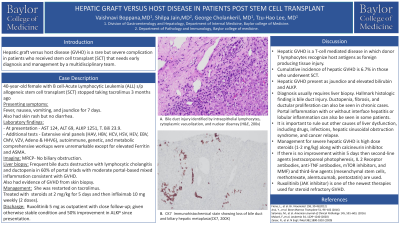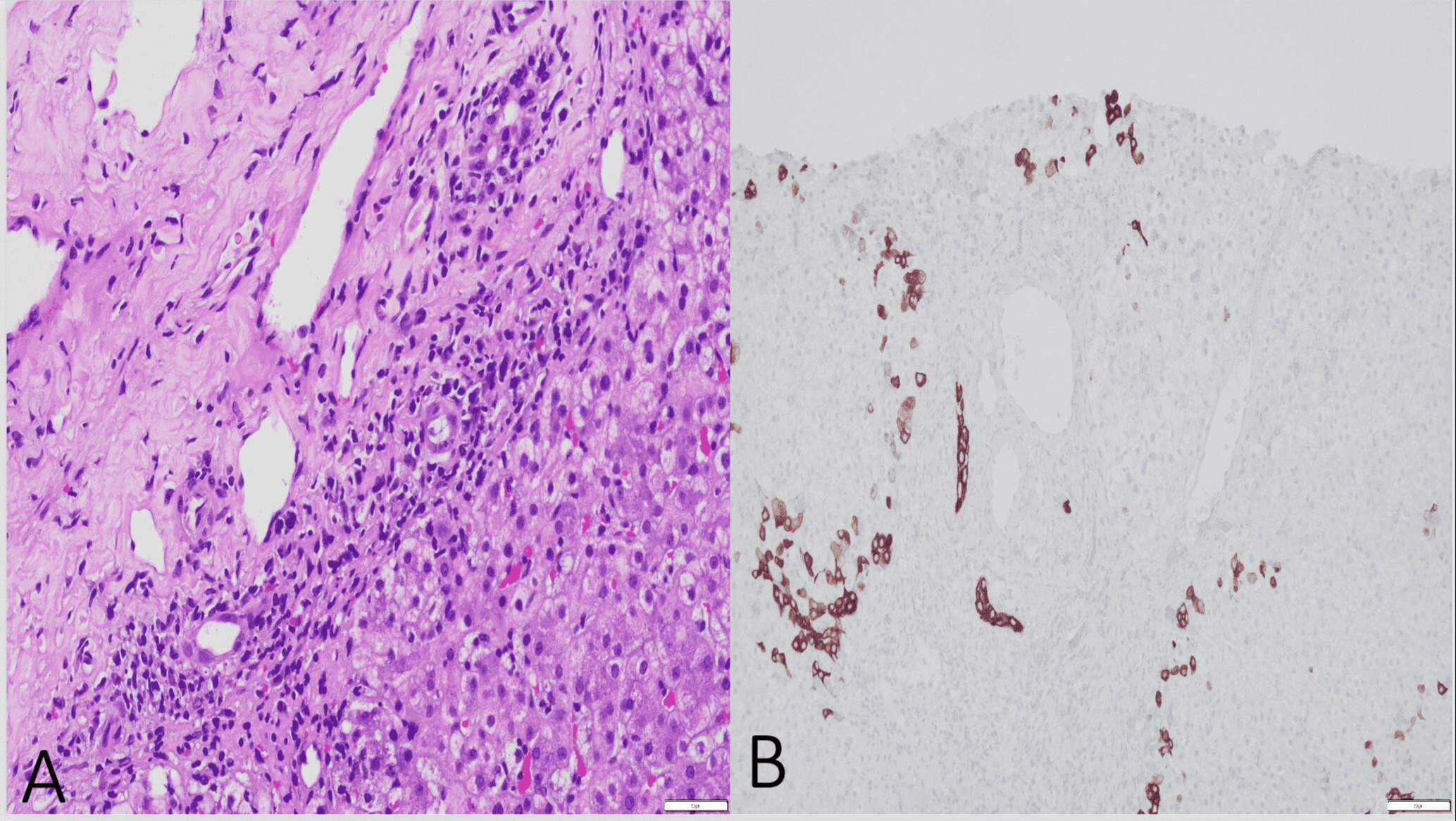Back


Poster Session B - Monday Morning
Category: Liver
B0599 - Hepatic Graft vs Host Disease in Patients Post Stem Cell Transplant
Monday, October 24, 2022
10:00 AM – 12:00 PM ET
Location: Crown Ballroom

Has Audio
- VB
Vaishnavi Boppana, MD
Baylor College of Medicine
Houston, TX
Presenting Author(s)
Vaishnavi Boppana, MD, Shilpa Jain, MD, George Cholankeril, MD, Tzu-Hao Lee, MD
Baylor College of Medicine, Houston, TX
Introduction: Hepatic graft versus host disease (GVHD) is a rare but severe complication in patients who received stem cell transplant (SCT) that needs early diagnosis and management by a multidisciplinary team.
Case Description/Methods: 40-year-old female with B cell-Acute Lymphocytic Leukemia (ALL) s/p allogeneic stem cell transplant (SCT) stopped taking tacrolimus 3 months ago, and presented with fever, nausea, vomiting, and jaundice for 7 days. She also had skin rash but no diarrhea. Liver tests on presentation include AST 124, ALT 69, ALKP 1251, T. Bili 23.9. Extensive viral panels were negative (HAV, HBV, HCV, HSV, HEV, EBV, CMV, VZV, Adeno & HHV6). The autoimmune, genetic, and metabolic comprehensive workups were unremarkable except for elevated Ferritin and ASMA. MRCP did not show biliary obstruction. Histology results from the liver biopsy showed frequent bile ducts destruction with lymphocytic cholangitis and ductopenia in 60% of portal triads with moderate portal-based mixed inflammation consistent with GVHD. She also had evidence of GVHD from skin biopsy. After admission, she was restarted tacrolimus and steroids at 2 mg/kg for 5 days and then infliximab 10 mg weekly (2 doses). Given otherwise stable condition and 50% improvement in ALKP, she was discharged on ruxolitinib 5 mg as an outpatient with close follow-up.
Discussion: Hepatic GVHD is a T-cell mediated disease in which donor T lymphocytes recognize host antigens as foreign producing tissue injury. The cumulative incidence of hepatic GVHD is 6.7% in those who underwent SCT. Hepatic GVHD present as jaundice and elevated bilirubin and ALKP. The diagnosis usually requires liver biopsy. Hallmark histologic finding is bile duct injury. Ductopenia, fibrosis, and ductular proliferation can also be seen in chronic cases. Portal inflammation with or without interface hepatitis or lobular inflammation can also be seen in some patients. It is important to rule out other causes of liver dysfunction, including drugs, infections, hepatic sinusoidal obstruction syndrome, and cancer relapse. Management for severe hepatic GVHD is high dose steroids (1-2 mg/kg) along with calcineurin inhibitor. If there is no improvement within 5 days then second-line agents (extracorporeal photopheresis, IL 2 Receptor antibodies, anti-TNF antibodies, mTOR inhibitors, and MMF) and third-line agents (mesenchymal stem cells, methotrexate, alemtuzumab, pentostatin) are used. Ruxolitinib (JAK inhibitor) is one of the newest therapies used for steroid refractory GVHD.

Disclosures:
Vaishnavi Boppana, MD, Shilpa Jain, MD, George Cholankeril, MD, Tzu-Hao Lee, MD. B0599 - Hepatic Graft vs Host Disease in Patients Post Stem Cell Transplant, ACG 2022 Annual Scientific Meeting Abstracts. Charlotte, NC: American College of Gastroenterology.
Baylor College of Medicine, Houston, TX
Introduction: Hepatic graft versus host disease (GVHD) is a rare but severe complication in patients who received stem cell transplant (SCT) that needs early diagnosis and management by a multidisciplinary team.
Case Description/Methods: 40-year-old female with B cell-Acute Lymphocytic Leukemia (ALL) s/p allogeneic stem cell transplant (SCT) stopped taking tacrolimus 3 months ago, and presented with fever, nausea, vomiting, and jaundice for 7 days. She also had skin rash but no diarrhea. Liver tests on presentation include AST 124, ALT 69, ALKP 1251, T. Bili 23.9. Extensive viral panels were negative (HAV, HBV, HCV, HSV, HEV, EBV, CMV, VZV, Adeno & HHV6). The autoimmune, genetic, and metabolic comprehensive workups were unremarkable except for elevated Ferritin and ASMA. MRCP did not show biliary obstruction. Histology results from the liver biopsy showed frequent bile ducts destruction with lymphocytic cholangitis and ductopenia in 60% of portal triads with moderate portal-based mixed inflammation consistent with GVHD. She also had evidence of GVHD from skin biopsy. After admission, she was restarted tacrolimus and steroids at 2 mg/kg for 5 days and then infliximab 10 mg weekly (2 doses). Given otherwise stable condition and 50% improvement in ALKP, she was discharged on ruxolitinib 5 mg as an outpatient with close follow-up.
Discussion: Hepatic GVHD is a T-cell mediated disease in which donor T lymphocytes recognize host antigens as foreign producing tissue injury. The cumulative incidence of hepatic GVHD is 6.7% in those who underwent SCT. Hepatic GVHD present as jaundice and elevated bilirubin and ALKP. The diagnosis usually requires liver biopsy. Hallmark histologic finding is bile duct injury. Ductopenia, fibrosis, and ductular proliferation can also be seen in chronic cases. Portal inflammation with or without interface hepatitis or lobular inflammation can also be seen in some patients. It is important to rule out other causes of liver dysfunction, including drugs, infections, hepatic sinusoidal obstruction syndrome, and cancer relapse. Management for severe hepatic GVHD is high dose steroids (1-2 mg/kg) along with calcineurin inhibitor. If there is no improvement within 5 days then second-line agents (extracorporeal photopheresis, IL 2 Receptor antibodies, anti-TNF antibodies, mTOR inhibitors, and MMF) and third-line agents (mesenchymal stem cells, methotrexate, alemtuzumab, pentostatin) are used. Ruxolitinib (JAK inhibitor) is one of the newest therapies used for steroid refractory GVHD.

Figure: A. Bile duct injury identified by intraepithelial lymphocytes, cytoplasmic vacuolization, and nuclear disarray (H&E, 200x)
B. CK7 immunohistochemical stain showing loss of bile duct and biliary hepatic metaplasia(CK7, 200X)
B. CK7 immunohistochemical stain showing loss of bile duct and biliary hepatic metaplasia(CK7, 200X)
Disclosures:
Vaishnavi Boppana indicated no relevant financial relationships.
Shilpa Jain indicated no relevant financial relationships.
George Cholankeril indicated no relevant financial relationships.
Tzu-Hao Lee indicated no relevant financial relationships.
Vaishnavi Boppana, MD, Shilpa Jain, MD, George Cholankeril, MD, Tzu-Hao Lee, MD. B0599 - Hepatic Graft vs Host Disease in Patients Post Stem Cell Transplant, ACG 2022 Annual Scientific Meeting Abstracts. Charlotte, NC: American College of Gastroenterology.

